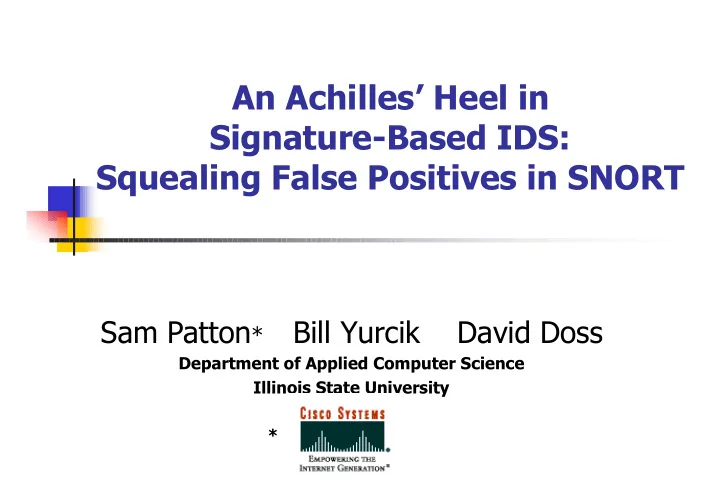

An Achilles’ Heel in Signature-Based IDS: Squealing False Positives in SNORT Sam Patton * Bill Yurcik David Doss Department of Applied Computer Science Illinois State University *
Overview � 1) the problem � 2) software tool � 3) generating FPs on Snort � 4) implications � 5) plausibility of attack � 6) detection � 7) the large issue of arbitrary F.P.generation RAID 2001
1) Problem: False Positives � the vulnerability of IDS to false positives is well-documented � we agree with Axelsson “the limitations of IDS is not the ability to accurately detect misuse behavior but rather the ability to suppress false alarms” RAID 2001
Testing IDS/Firewalls � test correctness of IDS/firwall configuration � simulate client-server characteristics of various attacks without using actual exploit code. � better simulation of tcp connections to make attack simulations more stateful � dangerously close to feature creep � # of new attacks increasing each month � false positive rates increasing proportionately � may not be the right approach RAID 2001
2) Software Tool � Purpose of tool � Naming of the tool � P acket C reation P rogram � negative connotation � SATAN, crack Phencyclidine � units are packets � packets are inhaled/snorted � user perception of extraordinary abilities RAID 2001
PCP Overview � Architecture � series of reusable C routines � series of generation tools � Usage � recreate simulations of packets which might cause problems in IOS-based routers � testing of Firewall rule base configuration correctness � attack simulation RAID 2001
PCP Features � Multi-protocol support within IP � Standard support for tcp, udp, icmp � Routing protocols � Series of interesting sample scripts � Currently working on better TCP sequence routine and RARP attacks RAID 2001
3) Generating FPs on Snort “Squealing” � SNORT (1.6.3, 1.8.1) source code, user base � Squealing (SNORT logo is a pig, noise made by pigs during times of distemperment) � The generation of network/host data with the intent of creating false positives in IDSs alert tcp $EXTERNAL_NET any -> $HOME_NET any (msg:"IDS345 - OVERFLOW-NOOP-Sparc- TCP";flags:PA; content:"|13c0 1ca6 13c0 1ca6 13c0 1ca6 13c0 1ca6|";) tcp_payload="\x13\xc0\x1c\xa6\x13\xc0\x1c\xa6\x13\xc0\x1c\xa6\x13\xc0\x1c\xa6\x13\xc0\x1c\xa6 [**] IDS345 - OVERFLOW-NOOP-Sparc-TCP [**] 04/16-12:07:12.896655 10.0.3.254:23 -> 10.0.3.101:23 TCP TTL:64 TOS:0x18 ID:0 *****PA* Seq: 0x7FFFFFFF Ack: 0x7FFFFFFF Win: 0x4470 RAID 2001
Linux and OpenBSD boxes running PCP SNORT sensors running off OpenBSD 2.8 RAID 2001
4) Implications � noise-masked attacks (peer review: diversion?) � attack misdirection � non-repudiation attack � target conditioning attack � statistical poisoning attack � also from peer review: � evasion?, decoy?, deception? RAID 2001
5) Plausibility of Squealing “in the wild” � environment for increased usage exists � tool availability increasing….knowledge needed to exploit this style of attack is decreasing. � CASL (Newsham Ptacek), STICK, SNOT, Trichinosis, libnet, nemesis, idswakeup � tool maturity and evasiveness RAID 2001
6) Detection of “Squealing” � detection today vs. detection tomorrow � static defaults (Nemesis) will be replaced with pseudo-random defaults � increased reliance on RFC 2267 filters � noticing signatures egress from network � need for link-based ingress filtering for detection….not just reliance on router-based filters � better simulation of two-way sessions from a single host RAID 2001
7) Future Protection From Arbitrary F.P. Generation � adaption (randomness) � state awareness � BUT as attack simulators become better at emulating state, the problem of squealing will reappear � thinking about NIDS design model � the concept of data direction (timestamped) RAID 2001
<http://www.sosresearch.org> RAID 2001
2.0) A quick primer on writing false network data � Two primary methods � SOCK_RAW and sendto() � bpf writes RAID 2001
2.1) Writing to the Network Layer � 1) malloc() memory � 2) Fill data structures and copy into buffer � in the 3) Open a raw socket fd = socket(AF_INET, SOCK_RAW, proto); � � 4) Call sendto() c = sendto(fd, buffer, len, 0, (struct sockaddr *)&sin, sizeof(struct � sockaddr)); � 5) Byte order issues on certain systems � i.e. Sometimes ip_length and ip_offset in host byte order RAID 2001
2.2) Writing to the Data Link � Get Datalink type � ioctl(l->fd, BIOCGDLT, (caddr_t)&v) � Linkoffset � l->linkoffset = 0xe; /*ethernet */ � Open file descriptor � l->fd = open(device, O_RDWR); � Attach to bpf device � (ioctl(l->fd, BIOCSETIF, (caddr_t)&ifr) � Writing to link layer � c = write(l->fd, buffer, len); RAID 2001
5.1) Detection of Squeals Today enet_src[0] = enet_dst[0] = 0x02; 0x0d; enet_src[1] = enet_dst[1] = 0x0f; 0x0e; enet_src[2] = enet_dst[2] = 0x0a; 0x0a; enet_src[3] = enet_dst[3] = 0x0d; 0x0d; enet_src[4] = enet_dst[4] = 0x0e; 0x00; enet_src[5] = enet_dst[5] = 0x0d; 0x01; RAID 2001
5.2) Detection of Squeals Today fl_opt = 0; Interesting sport = 42069; dport = 23; id = 0; urgp = 2048; tos = IPTOS_LOWDELAY | IPTOS_THROUGHPUT; RAID 2001
5.3) Detection of Squeals Today ttl = 254; Interesting seq = 420; ack = 420; win = 512; payload = NULL; *options = NULL; frag = IP_DF; RAID 2001
Recommend
More recommend